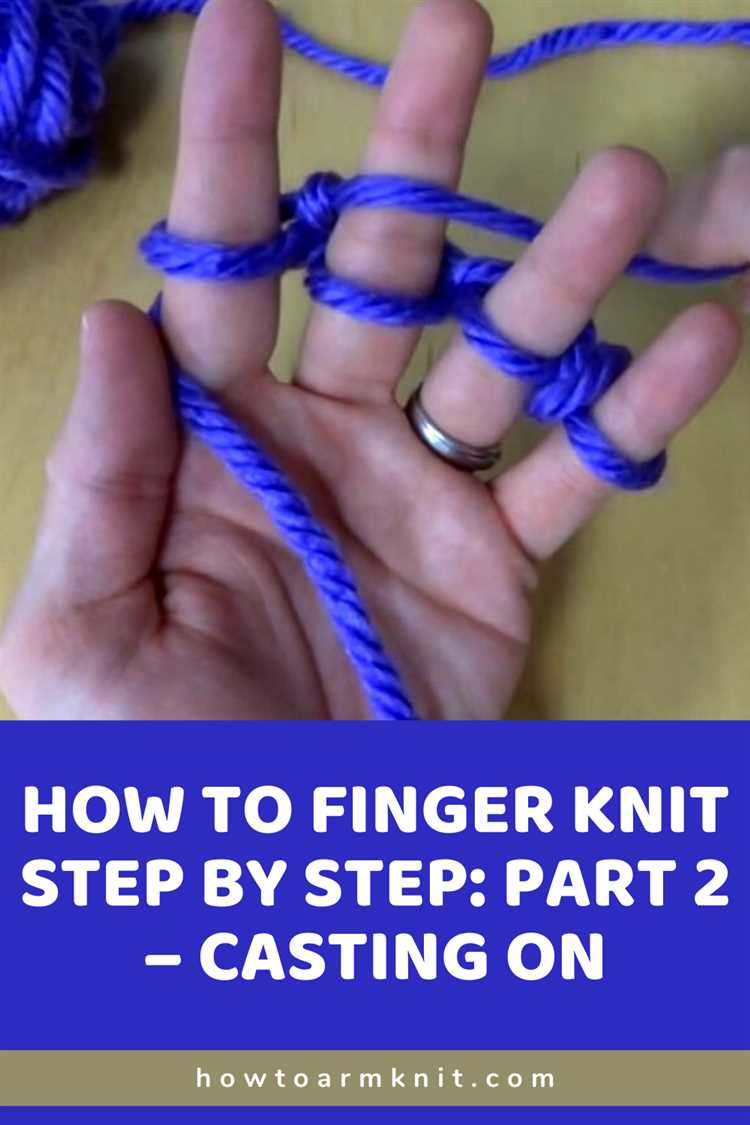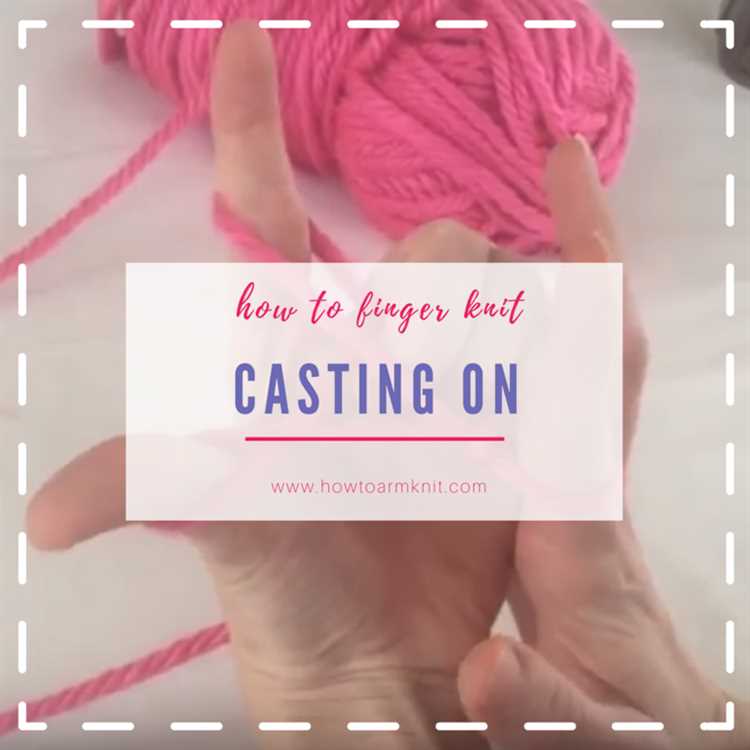Are you interested in finger knitting, but aren’t sure how to finish your project with a professional touch? Look no further! In this article, we will guide you through the easy steps to finish a finger knit like a pro.
Finger knitting is a fun and trendy way to create beautiful textiles without the need for needles or crochet hooks. However, many beginners struggle with completing their finger knitting projects and achieving a polished look.
With our step-by-step instructions, you’ll learn how to properly tie off your finger knitting, secure the yarn, and finish your project with a clean edge. Whether you’re creating a cozy scarf, a stylish headband, or a decorative wall hanging, these techniques will help elevate your finger knitting skills.
So, if you’re ready to take your finger knitting to the next level and achieve that professional finish, let’s dive into the easy steps for finishing a finger knit like a pro!
What is Finger Knitting?
Finger knitting is a popular craft technique that allows you to create beautiful knitted items without the use of knitting needles. Instead, you use your fingers to create loops and stitch them together to form a knitted fabric. It’s a fun and easy way to get started with knitting, especially for beginners or those who may struggle with traditional knitting techniques.
The best part about finger knitting is that you can do it anywhere, anytime, using just a ball of yarn. It doesn’t require any special equipment, making it a great portable craft for road trips, vacations, or even just relaxing at home. Plus, it’s a great way to destress and unwind after a long day.
With finger knitting, you can create a variety of items, from simple scarves and headbands to more complex blankets and shawls. The possibilities are endless, and you can customize your creations by using different colors and types of yarn.
One of the great things about finger knitting is that it’s suitable for all ages. Children as young as five can learn to finger knit, making it a great craft activity to do together as a family. Plus, it’s a great way to introduce kids to the world of knitting and spark their creativity.
Whether you’re a seasoned knitter looking for a new technique or a beginner interested in learning how to knit, finger knitting is a versatile and accessible craft that anyone can enjoy. So grab a ball of yarn and get ready to knit with your fingers like a pro!
Choosing the Right Yarn
When it comes to finger knitting, choosing the right yarn is essential to achieve the desired results. Here are a few factors to consider when selecting your yarn:
- Weight: Yarns come in different weights ranging from lightweight to super bulky. The weight of the yarn you select will determine the final thickness and warmth of your finger knitted project. Consider the type of item you want to create and choose a yarn weight accordingly.
- Material: Yarns are made from various materials, including wool, acrylic, cotton, and blends. Each material has its own unique characteristics, such as softness, breathability, and durability. Think about how you want your finished piece to feel and look, and choose a yarn material that aligns with your preferences.
- Texture: Yarns can have a smooth or textured surface. The texture of the yarn can add visual interest and dimension to your finger knitting. Consider whether you want a plain and simple look or a more intricate texture, and choose a yarn accordingly.
- Color: Yarns come in a wide range of colors, from solid to variegated and self-striping. The color of the yarn can greatly impact the overall look of your finger knitted project. Consider the color scheme you have in mind and choose a yarn that complements your desired aesthetic.
- Budget: Yarn prices can vary greatly depending on the brand, material, and quality. Consider your budget and choose a yarn that fits within your price range. Remember, there are affordable options available that still provide excellent results.
By considering these factors when choosing your yarn, you can ensure that your finger knitting project turns out beautifully and meets your expectations. Happy finger knitting!
Casting On
Before you can begin finger knitting, you need to cast on, which is the process of creating the stitches on your fingers. Follow these easy steps to cast on:
- Start with a slip knot: First, make a loop with the yarn, crossing the end over to create a knot. Pull the slip knot tight to secure it, but not too tight.
- Place the slip knot on your finger: Place your finger through the loop of the slip knot, pulling it snugly around your finger.
- Loop the working yarn: Take the working yarn (the yarn attached to the ball) and loop it over your thumb, keeping it in front of your finger with the slip knot.
- Weave the working yarn: Bring the working yarn behind your finger, then slip it under the slip knot loop on your finger.
- Repeat the process: Repeat steps 3 and 4, continuing to weave the working yarn around your fingers and under the slip knot loop, until you have casted on the desired number of stitches.
- Remove the slip knot: Once you have casted on enough stitches, carefully slip the slip knot off your finger and tighten the loop around the stitches to secure them.
Now you are ready to start finger knitting! Casting on is an essential step that creates the foundation for your finger knitting project. Take your time to master the casting on technique before moving on to the next steps.
Basic Finger Knitting Stitch
Finger knitting is a fun and easy craft that you can do with just your hands and some yarn. The basic finger knitting stitch is the foundation of all finger knitting projects, so it’s important to master this stitch before moving on to more advanced patterns.
To start, make a slipknot by creating a loop with the yarn and pulling the tail end through the loop. Slide the slipknot onto your index finger and tighten it so that it fits snugly but not too tight.
Place your thumb on top of the yarn and weave it under and over the yarn. Now, bring your index finger forward and push it through the loop on your thumb. Pull the yarn through the loop, creating another loop.
Slide the new loop onto your thumb and tighten it. Repeat steps 2 and 3, alternating between your thumb and index finger, until you reach your desired length.
Remember to keep the tension of the yarn consistent throughout your finger knitting. If the yarn is too tight, the knitted fabric will be stiff and difficult to work with. If the yarn is too loose, the knitted fabric will be loose and floppy.
Once you’ve mastered the basic finger knitting stitch, you can start experimenting with different yarn colors and textures to create beautiful and unique projects. Whether it’s a cozy scarf, a decorative wall hanging, or a cute headband, the possibilities are endless with finger knitting!
Increasing and Decreasing Stitches
Once you have mastered the basic finger knitting technique, you can explore more advanced techniques such as increasing and decreasing stitches. These techniques allow you to create more complex patterns and designs in your finger knitting projects.
Increasing Stitches:
To increase stitches in finger knitting, you will need to add extra loops to your working yarn. This will create additional stitches and make your project wider.
- Begin by finger knitting a few rows with your desired yarn.
- When you reach the point where you want to increase stitches, instead of knitting into the already existing loops, create new loops by pulling the working yarn through the loops on your fingers.
- Continue finger knitting as usual, incorporating the new loops into your pattern.
Decreasing Stitches:
To decrease stitches in finger knitting, you will need to remove loops from your working yarn. This will make your project narrower and create interesting shaping effects.
- Begin by finger knitting a few rows with your desired yarn.
- When you reach the point where you want to decrease stitches, instead of adding new loops, slip the first loop off your finger without knitting into it.
- Continue finger knitting as usual, skipping the slipped loop. This will decrease the number of stitches in your project.
Tips:
- Practice increasing and decreasing stitches on a small swatch before incorporating them into a larger project.
- Experiment with different ways of increasing and decreasing stitches to create unique patterns and designs.
- Keep track of the number of stitches in your project to maintain symmetry and balance.
With practice, you will become more comfortable with increasing and decreasing stitches in finger knitting. This opens up a world of possibilities for creating intricate and beautiful finger knitting projects!
Adding Color
Adding color to your finger knitting can be a fun and creative way to personalize your projects. Here are a few easy steps to add color:
- Select your yarn: Choose yarn in the colors you want to incorporate into your finger knitting project. You can choose a single color yarn or multiple colors for a more vibrant design.
- Combine colors: If you’re using multiple colors, you can either alternate the colors as you knit or create color blocks by knitting with one color for a few rows and then switching to another color.
- Attach new yarn: When you’re ready to add a new color, simply tie the end of the new yarn to the end of the previous yarn in a secure knot. Leave a tail of about 6 inches or so to weave in later.
- Continue knitting: Once your new yarn is attached, continue finger knitting as usual, incorporating the new color into your stitches. You can experiment with different knitting patterns to create interesting color patterns or keep it simple with basic stitches.
- Secure loose ends: When you reach the end of your finger knitting project, make sure to secure any loose ends by weaving them into the stitches. This will help to prevent unraveling.
Adding color to your finger knitting can take your project to the next level and allow you to create unique and eye-catching designs. Don’t be afraid to experiment and have fun with different color combinations!
Casting Off
Once you have finished your finger knitting project, it’s time to cast off. Casting off is the process of taking the loops off your fingers and securing the end of your knitting. Here are the easy steps to finish a finger knit like a pro.
- Start by knitting two stitches onto your index finger.
- Take the bottom loop and lift it over the top loop, then off your finger.
- Repeat step 2 with the remaining stitches until you have only one loop left.
- Cut the yarn, leaving a long tail.
- Thread the tail through the loop and gently pull to secure the end of your knitting.
And there you have it! You have successfully cast off your finger knitting project. Now you can admire your finished creation or use it for whatever purpose you had in mind.
Remember, practice makes perfect. Don’t be discouraged if your first attempt doesn’t turn out exactly as you hoped. Keep trying and soon you’ll be casting off like a pro!
Fixing Mistakes
Even with practice, mistakes happen. But don’t worry! Fixing mistakes when finger knitting is easy. Here’s how you can correct common errors:
Dropped stitch
If you notice a dropped stitch, simply use your finger or a crochet hook to pick up the dropped stitch and place it back onto the adjacent finger. Make sure the loop is not twisted and continue knitting as usual.
Wrong stitch
If you accidentally use the wrong finger or skip a finger when knitting, you can simply undo the last stitch and reposition it on the correct finger. Carefully slide the loop off the incorrect finger and onto the correct one. Make sure not to twist the loop and continue knitting as before.
Tight stitch
If you find that your stitches are too tight, you can gently pull on the working yarn to loosen the tension. Remember to maintain an even tension throughout your knitting to ensure consistent results.
Uneven tension
If you notice that some stitches are tighter or looser than others, it may be due to uneven tension. To fix this, you can go back to the tighter stitches and gently pull on the working yarn to even out the tension. Take your time to adjust each stitch individually until you achieve the desired consistency.
Skipping a row
If you accidentally skip a row, you can carefully unravel the last row by pulling on the working yarn. Be sure to unravel slowly to avoid any tangling or dropping of stitches. Once you have unraveled the desired number of rows, you can reposition the loops back onto your fingers and resume knitting from the row where you made the mistake.
Remember, practice makes perfect. Don’t be discouraged by mistakes, as they are a natural part of the learning process. With time and experience, you’ll become more skilled at fixing errors and producing beautiful finger knitting projects.
FAQ:
What materials do I need to finger knit?
To finger knit, you will need a ball of yarn and your fingers. That’s all!
Is finger knitting easy to learn?
Yes, finger knitting is very easy to learn. It is a great craft for beginners, including children, as it doesn’t require any special tools or equipment.
Can you use any type of yarn for finger knitting?
Yes, you can use any type of yarn for finger knitting. However, thicker yarns are generally easier to work with as they are less likely to slip off your fingers.
How long does it take to finish a finger knit project?
The time it takes to finish a finger knit project depends on the size of the project and your knitting speed. A small scarf or bracelet can be finished in a few hours, while a larger blanket may take several days.
What can I make with finger knitting?
You can make a variety of items with finger knitting, including scarves, headbands, bracelets, blankets, and even stuffed animals. The possibilities are endless!
Are there any tips for making my finger knit project look more professional?
Yes, there are a few tips for making your finger knit project look more professional. One tip is to keep the tension consistent throughout your knitting to ensure even stitches. Another tip is to weave in any loose ends neatly to give your project a polished look.
Is finger knitting only for kids?
No, finger knitting is not just for kids. While it is a great craft for children to learn, adults can also enjoy finger knitting as a relaxing and creative hobby.


